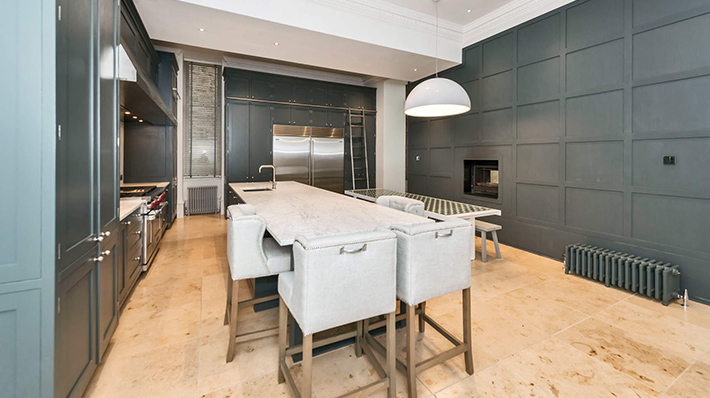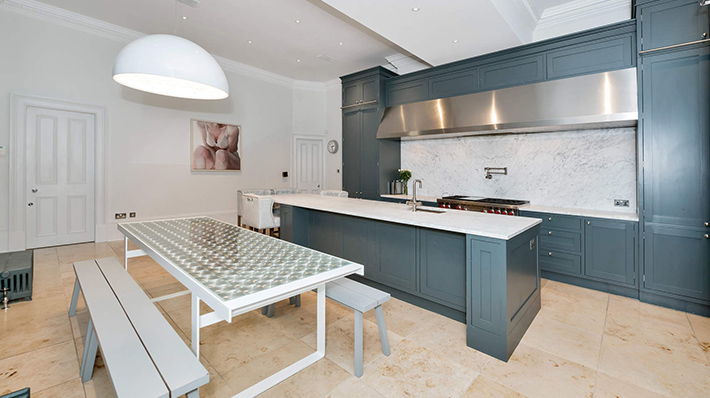How to plan and design a bespoke kitchen
Posted on June 4th, 2024 by Severino Group
Reading time 10 minutes
A well-designed kitchen elevates the aesthetic appeal of your home and enhances your daily routine, making cooking, entertaining, and spending time with loved ones a true pleasure. Even for those looking to elevate their property developments, the value of a kitchen space is not to be ignored.
To help you navigate this exciting journey, we’ve compiled 10 essential tips to guide you through planning and designing your dream kitchen. Whether you envision a modern, minimalist space or a cosy, traditional kitchen, these insights will ensure your new kitchen is as functional as it is beautiful.
1. Set Your Goals and Requirements
The first step in creating your dream kitchen is clearly defining its purpose. Will it be primarily a space for culinary adventures, or will it also serve as a hub for entertaining guests? Understanding how you intend to use the kitchen will guide every other decision in the design process.
Consider your style preferences as well. Do you lean towards a sleek, contemporary look, a timeless traditional style, or a cosy rustic charm? By understanding your aesthetic preferences early on, you ensure that your kitchen design will be cohesive with the rest of your home.
Finally, establish a budget that reflects the value you want to achieve. Remember, a bespoke kitchen is an investment, and planning your finances carefully will help you allocate resources to the features that matter to you most.
2. Plan the Kitchen Layout
The layout of your kitchen is crucial to its functionality. Consider the workflow—how you move between the sink, stove, and refrigerator. This is often called the “work triangle,” and optimising this can make cooking more efficient and enjoyable.
To do this, consider the zones within your kitchen space, such as prep, cooking, cleaning, and storage areas. Intelligent storage solutions like pull-out cabinets and shelves will allow you to maximise your space and keep the kitchen clutter-free.
Ergonomics should also be at the forefront of your design so that your kitchen is curated with ease of use in mind, with everything in reach and at a comfortable height. This not only enhances functionality but also ensures your space is comfortable and enjoyed.
3. Select the Appliances
Choosing the right appliances is a crucial aspect of bespoke kitchen design. High-quality, reliable appliances are a must; their style should complement the kitchen’s overall design. Attention to detail on such matters will help elevate your space and show thoughtful intrigue in its functionality and aesthetics. Whether you prefer state-of-the-art technology or classic designs, your appliances should seamlessly integrate into the layout.

4. Pick High-Quality Materials
The materials you choose will define the look and feel of your kitchen. For countertops, consider options that offer both durability and beauty, such as granite, quartz, or marble. Each material has its own characteristics, so choose one that aligns with your lifestyle and design preferences.
When selecting cabinetry, consider the type of wood and finish that will best suit your kitchen’s style. From sleek, lacquered finishes to warm, rich woods, your cabinetry should be both practical and visually appealing.
Don’t overlook the flooring and backsplash. These elements play a crucial role in tying the design together and adding texture and colour. Consider materials that are easy to maintain while still offering a luxurious finish.
5. Consider the Plumbing and Electric Work
Behind every beautifully designed kitchen is a plumbing and electrical work network that keeps it functioning smoothly. It is important to plan for these elements early in the design process and ensure that the infrastructure can support your chosen appliances and layout.
Lighting is another critical factor. Well-placed task lighting can make food preparation easier, while ambient lighting can set the mood for entertaining. Integrating innovative technology, such as programmable lighting or voice-activated controls, can open up a world of possibilities and enhance the kitchen’s functionality.
6. Aim for a Timeless Design
To future-proof your kitchen, you must consider how the space might evolve with your lifestyle and taste.
While kitchen trends may capture attention, they often fade just as quickly, leaving your space feeling dated. Aiming for a timeless design ensures that your kitchen remains stylish and functional for years to come. Start with a foundation of classic elements, such as Shaker-style cabinets or marble countertops, which have stood the test of time in both aesthetics and durability.
Neutral colour palettes are another cornerstone of timeless design. Shades like soft whites, warm beiges, or muted greys provide a versatile backdrop that can easily be refreshed with changing accessories or accents, ensuring your kitchen always feels current. Consider integrating subtle textures, like subway tiles or natural stone, to add depth and interest without overwhelming the space.
7. Be Open to Inspiration
While having a clear vision is important, don’t be afraid to seek inspiration from various sources. Browse design magazines, visit showrooms, and consult with professionals to explore new ideas and possibilities. Sometimes, the perfect design element is one you hadn’t initially considered.

8. Personalise Your Kitchen
Your kitchen is more than just a place to cook—it’s a space that should reflect your personality, tastes, and lifestyle. Personalising your kitchen allows you to infuse it with character and charm, making it a true extension of your home.
Start by considering custom features that cater to your unique needs and preferences. A built-in wine rack or a climate-controlled wine fridge can be an elegant and functional addition for wine enthusiasts. If you’re a passionate cook, consider integrating a bespoke spice drawer or custom cabinetry designed to house your collection of culinary tools. A statement kitchen island, designed with your preferred height and materials, can serve as both a functional workspace and a social hub for gatherings.
Decorative elements like artwork, designer accessories, and stylish lighting are not just embellishments- they can further enhance the ambience, adding character and warmth to your kitchen and making you feel comfortable and at home. These thoughtful touches make your kitchen functional and a true reflection of your taste and personality.
9. Create an Appropriate Timeline
Designing and building a bespoke kitchen takes time, and setting a realistic timeline is important. Consider the scope of the project and any potential delays. Working closely with your designer will help ensure that the project stays on track and that your kitchen is ready when needed.
10. Collaborate with Experienced Kitchen Designers
The key to a successful bespoke kitchen lies in working with experienced professionals who understand your vision and can create a design that is truly unique to you. Here at Severino, we have years of experience in crafting bespoke kitchens that blend functionality with luxury. Our team is dedicated to bringing your dream kitchen to life, from the initial design to the final installation, ensuring that it is as unique as you are.
To explore how we can help you create your perfect kitchen, contact us today at 0141 334 6674 or enquiries@severino-group.com. Let’s turn your vision into reality with a bespoke kitchen that’s as unique as you are.
